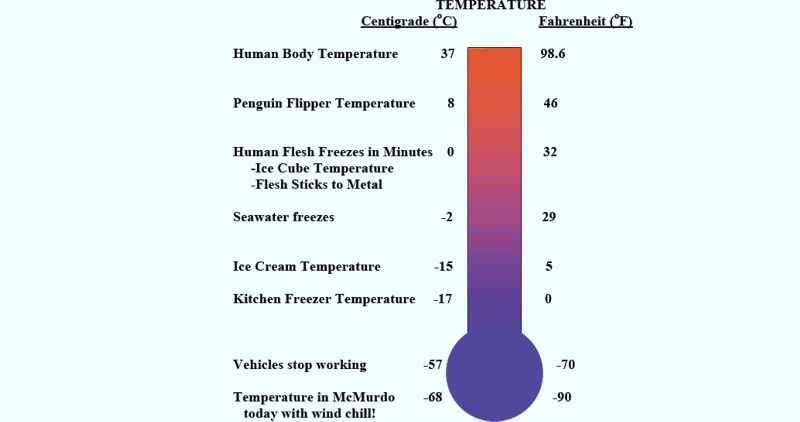Mid-afternoon winds blow snow across the sea ice in McMurdo Sound, creating “fire on ice” in late August. |
|||||||||||||||
THE JOURNEY It took eight years of planning, months of packing and weeks of travel to get to this point. There are eight team members in our expedition that have travelled 9167 miles (14,752 kilometers) across the oceans to arrive on the sea ice surrounding Antarctica to study the underwater hunting behavior of the Weddell seal. |
|||||||||||||||
| THE COLD | |||||||||||||||
Cold Bodies It is cold here- bitterly, bone-chilling, flesh-freezing cold at this time of year in Antarctica. Every day the air temperature barely hovers over -42°F (-41°C). With wind chill we have experienced several days at -70°F |
|||||||||||||||
 |
|||||||||||||||
| But the cold also brings beauty to the Antarctic winter. When temperatures reach below -121°F (-85°C) gaseous nitric acid literally freezes out of the stratosphere. The resulting ice crystals create spectacular, rainbow-colored Polar Stratospheric Clouds, called nacreous clouds. At dawn and dusk the clouds form, leaving our expedition members in awe. However, hidden behind the beauty of the clouds is a deadly side - nacreous clouds are the sites of destruction of the ozone layer and home to the earth’s “ozone hole”. As if the cold were not enough, our expedition members have to be wary of severe sunburn due to the loss of the protective ozone layer over Antarctica at this time of year. |
|
||||||||||||||
The extreme cold also affects our minds. With the sudden exposure to cold our thyroid hormones go into hyper-drive. While this helps our bodies generate more heat, it has a strange side effect. We begin to experience a decline in our short term memory. Remembering even the simplest things becomes difficult. Simple requests, telephone numbers, names, and to do lists are quickly forgotten. Recognizing our handicap, we begin to use our “green brains”. These are small green, government issued notebooks that we keep in our pocket to jot down notes. It is the closest thing to a Blackberry on ice (which would be nice but don’t work well when their batteries freeze at the -40 degree temperatures). |
|||||||||||||||
LIFE BELOW THE ICE The severe weather has caused all of the Weddell seals to go into hiding; even an Antarctic seal is not willing to face the wind and the cold on top of the ice. Instead, they stay in the ocean water underneath the ice where there is no wind or blizzards, and the temperatures stay constant at a balmy 29°F (-2°C). |
|||||||||||||||
After a week of setting up camp on the sea ice we have yet to see one seal. Yet, we know they are here. We’ve seen the holes that their noses leave in the ice when they breathe. Even better than the holes, we can feel the seals’ presence through our boots. Standing on the ice, if you are really quiet and really still, you can hear them calling to one another in the seawater below. A video camera dropped into one of the breathing holes reveals the under ice world of the Weddell seal.
Listen for yourself: |
|||||||||||||||
|
|||||||||||||||